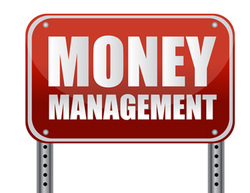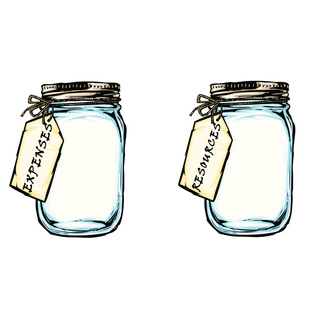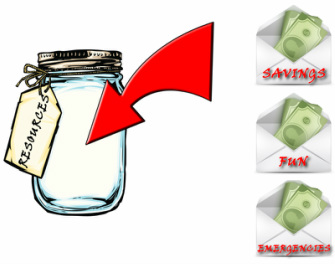 I’m careful with money – I didn't always manage it well, but I was careful. I've been that way ever since I can remember. Most people aren't though. I learned this the hard way. I've found the problem isn't always that people don’t value money; it’s just that they don’t watch what, goes where. They were never taught to budget. And let’s be honest, budgeting sucks! But this is a necessary life skill. Although I would hesitate to call this simple system budgeting, the model can be used to create one. So to be clear, this system is not budgeting, this is just simple money management and it’s EASY! Seriously, I've taught this to 14 and 15 year old's. All you need is some paper and a calculator – let’s go! Now imagine that you have two good old fashioned glass jars in front of you. One jar is labeled “EXPENSES” and the other jar is labeled “RESOURCES”. What we’re going to do is put money into these “glass jars”. Not in real life, just on paper.  Once you set this system up – you won’t have to do it again. You will be able to add or subtract as your life situation changes. Also, you don’t need to calculate everything down to the penny (unless you absolutely want to. I don’t). We will be dealing in general ballpark figures. Again, just enough attention to detail so you know where your money is currently going, where it needs to go or where it's about to go. Be careful not to make this very simple system, over complicated. Yes you can get very detailed, but if you don’t have to, then I suggest you don’t. Now, here’s how this works: (1) Look at all your monthly expenses and write them down. This includes everything that you pay monthly. Below is just a general list to get your mind working. Take what you need – feel free to add and subtract from it. Again – try not to over complicate this. It will drive you nuts! Write down each category separately. *NOTE* To get an idea of what you spend per month, look at your last 3 bills and take the average (add the total of all 3 bills and then divide by 3). If you don’t know how much you spend per month on something, you must make an effort to carefully track it for one full month. Once you do this, you can set it and forget it. Again we just need ball park figures. Write down each category separately:
(2) Multiply each category by 12 for the 12 months in a year. This will give you an idea of how much you spend on each category per YEAR. Write these numbers down on a separate sheet of paper. (3) Add up ALL your 12 month (YEARLY) totals from step 2 – This total will be called “Expenses”. (4) Now you need to get a fairly accurate assessment of how much you bring in per YEAR in income. Do NOT count tax return money! When you have your total, write this down. This total will be called “Income”. (5) Take your “Income” from step 4 and subtract the yearly “Expenses” from step 3. Write this number down, circle it and put “RESOURCES” next to it. All this math is to give you a yearly overview of where your money is going. Sounds like a lot of work, doesn't it? Trust me, that was the hard part. The rest is easy. Since you know how much money you must spend per month to take care of all your bills (the totals from step 1) – any extra money for that MONTH, goes into the “RESOURCES Glass Jar”. 1 jar for “EXPENSES” and 1 jar for “RESOURCES”, remember? We’re keeping watch of our finances per MONTH (if weekly works better for you, then do it!). Now let’s focus on your “RESOURCES glass jar” (money that you have left over per month). Now, imaging we’re going to put 3 envelopes in this jar, each one with a different label.
(1) Savings. (2) Fun – This includes entertainment, vacations, luxury items (jewelry, televisions, new mobile devices, etc.), etc. (3) Emergencies. I personally put around 50% into “Savings” then 25% into “Fun” and 25% into “Emergencies”. Planning on a vacation or thinking of buying that huge new flat screen? Put a little more in the “Fun” envelope every month. Don’t put it all in there, just a little extra. Easy, isn't it? Again this is my suggestion but do what works for you. You can also put this “RESOURCES” money toward starting a business or making an investment. But I highly recommend setting some of this money aside for emergencies. Cars break down; things around the house suddenly stop working, children get sick, the family dog chews up 5 pairs of your favorite shoes – you get the idea. Knowing where your money is going, and knowing you have some money set aside for savings and emergencies is very empowering. This can relieve some unnecessary stress in your life – trust me. Have any tips or tricks to help others? Please share by leaving a comment. Until next time. Want more? Subscribe to the Uncommon Sense Adviser – Free news, early access to future books, discounts and answers to questions too controversial for the blog. Join now by clicking [HERE]
1 Comment
Jase Amillion
10/8/2021 12:07:51 pm
Excellent advice made simple. The Jar analogy was the best because the image is clear.
Reply
Leave a Reply. |
Author
|





 RSS Feed
RSS Feed
